
Types Of Tiles
Beginners Guide To Different Types Of Tiles
Selecting the tiles from different types of tiles for your house makeover project is a big decision. The tile flooring is the most visible part of your home’s interior.
The type of tile you choose for the floor of your house can make a huge difference in your home improvement project. The selection of the right type of floor is an important decision, considering the cost implications and time required to change the floor of the house.
Any change of mind with regards to the color shade of the room can be easily corrected, but that option is not possible for the house tile flooring. And therefore, selecting the right tiles for your house can protect you from future hassles and maintenance issues.

Any floor renovation work takes a considerable amount of time, effort, and money. Further, the tile makeover project involves considerable civil work and is a costly affair.
However, choosing the right tiles for your house from the wide range of tiles available on the market is not that simple. Knowledge of different types of tiles and their technical features can help you in the selection process.
And therefore, it makes sense to scrutinize all the flooring options available to you before you finalize the tiles for your house.
This article will provide you with information about twenty-five different types of tiles commonly used in home interior and exterior DIY projects.
Different Types Of Tiles
Table Of Contents
Natural Stone Tiles
The marble tiles and granite tiles are the two most commonly used natural material tiles available in the market.
Both marble and granite tiles are extensively used for home interior design and also in the construction industry.
The marble is a type of metamorphic rock ( soft stone ) . Whereas, the granite is an igneous rock ( hard stone ). Both marble and granite tiles are available in large and small standard sizes.
The natural stone tiles are manufactured by cutting and polishing the natural rocks into standard tile sizes.

The type of the stone ( rock ) used in the tile is a crucial factor that decide the physical properties and the strength of the natural stone tile.
The other natural stone tile material include black stone ( Kadappa stone ) , Slate stone and kota stone ( type of Greenish-blue dolomite stone).
Another commonly used popular natural limestone tiles include Shahabad stone tiles. These tiles are used for exterior use.
- Kota Stone Tiles.
- Shahabad Stone Tiles.
- Sandstone Stone Tiles.
Manufactured Tiles
Ceramic Tiles
Porcelain Tiles
Vitrified Tiles
The term manufactured tiles in the context of flooring refers to all types of tiles other than the natural stone tiles. Alternately, we can also call this category as artificial tiles or synthetic tiles.
The manufactured tiles are fast replacing the natural stone tiles due its inherent advantages and the cost consideration.
The most commonly used manufactured tiles include ceramic tiles, porcelain tiles, vitrified tiles, terracotta tiles, cement tiles and other such tiles.
The tile market is dominated by the manufactured ( other than natural tiles ) tiles also referred as artificial tiles. All the tiles other than natural stone tiles come under this category.

The manufactured tiles are composite tiles made up of mixture natural material, chemicals and additives.
The major ingredients of manufactured are clay, silica, quartz, feldspar white clay, sand, some chemicals, binders and additives.
This mixture is then placed into the tile molds and subjected to heat treatment along with pressure treatment. The features and properties of the tile depend upon the chemical composition and the manufacturing process.
With the advancement in the tile manufacturing related technology and the digital printing technology, the manufactured tiles designs can replicate the looks and beauty of the natural stones.
Types Of Manufactured Tiles
- Terracotta Tiles.
- Cement Tiles.
- Paving Blocks Tiles.
Latest Designs In Manufactured Tiles
The latest digital printing technology can imitate the looks of the Italian marbles into the manufactured tiles. These tiles offer the beauty of marble and the strength of manufactured tiles.
The replication technology used to manufacture these tiles is so advanced that it is difficult to notice any difference between the original natural Italian marble and its replica as a vitrified tile.
Another major advantage for manufactured tiles is the price. These tiles are relatively far cheaper as compared to the original natural marble tiles.


Difference Between Porcelain And Vitrified Tiles
Porcelain tiles and vitrified tiles are both popular choices for flooring and wall covering in homes and commercial spaces. While they share some similarities, they differ in their composition, properties, and manufacturing process.
While both porcelain tiles and vitrified tiles offer similar benefits, they differ in their composition, properties, and manufacturing process. Porcelain tiles are made from a mixture of clay and other materials and are known for their strength and durability. Vitrified tiles are made by fusing silica and clay to create a glass-like material that is even stronger than porcelain tiles.
Here are the key differences between porcelain tiles and vitrified tiles:
Composition:
Porcelain tiles are made from a mixture of clay and other materials such as feldspar, kaolin, and quartz. They are fired at high temperatures to achieve a hard, dense, and non-porous material.
Vitrified tiles, on the other hand, are made by fusing silica and clay at high temperatures to create a glass-like material that is resistant to water and stains.
Properties:
Porcelain tiles are known for their strength and durability, making them ideal for high-traffic areas. They are also resistant to scratches, moisture, and stains.
Vitrified tiles are even stronger than porcelain tiles and can withstand heavy foot traffic, making them suitable for commercial spaces. They are also resistant to water, stains, and scratches.
Manufacturing Process:
Porcelain tiles are manufactured using a dust-pressed method, where dry clay is pressed into a mold and then fired at high temperatures. This results in a dense and hard material.
Vitrified tiles, on the other hand, are manufactured using a vitrification process, where the mixture of silica and clay is fused together at high temperatures to create a glass-like material.
Marble Tiles
The marble tiles are extensively used for different types house interior applications. The marble is basically a metamorphic rock ( Soft Stone ). It is widely available in various color shades in different parts of the world.
The elegant look of the marble and the grandeur makes marble a very special stone for interior work.
The marble tiles are available in different sizes. However, it is a standard practice to source the marble in large size tiles ( 4 feet X 8 feet ) and then cut the large marble tile into the required size as per the requirement.

The pricing of the marble tiles depends upon the quality and the size. The premium quality marble such as Italian marble is sold in large size tiles ( 4 feet X 8 feet size ) .
Whereas, the cheaper quality marble tiles are available in the standard sizes such as ( 12 by 12 inch , 24 by 24 inch, 24 by 48 inch ) etc.
The marble tiles need a very careful use and relatively high maintenance. And therefore, marble tiles are not recommended for heavy traffic area.
The marble tiles are available in different types and color shades. On the basis of color, the most common type of marble include white marble, green marble, pink marble, brown marble,black marble and yellow marble.
Types Of Marble Tiles
- White Marble Tiles.
- Green Marble Tiles.
- Pink Marble Tiles.
- Brown Marble Tiles.
- Black Marble Tiles.
- Yellow Marble Tiles.
Advantages Of Marble Tiles
- Great Looks.
- Easily Available.
- Wide Color Choice.
- Good Strength.
Disadvantages Of Marble Tiles
- High Maintenance.
- Requires Polishing.
- Low Stain Resistance.
- Low Scratch Resistance.
Granite Tiles
The granite tiles are also widely used for different applications for home interior and the exterior design. The granite is the most popular choice for kitchen counter tops.
The granite is basically a type of igneous rock ( hard stone ). It is easily available in various color shades and patterns in different parts of the world.
The granite tiles are considered to be the best natural stone well known for its strength , durability and the elegance. The granite tiles are usually polished for high gloss finish.
The joint less finish of the granite tiles creates an elegant look and the grandeur. The superior properties of the granite make it a very special stone suitable for both interior and the exterior work.

The granite tiles are available in different sizes. However, it is a standard practice to source the granite in large size tiles ( 4 feet X 8 feet ) and then cut the large granite tile into the required sizes as per the requirement.
The pricing of the granite tiles depends upon the quality and the size. The premium quality granite used for the flooring, kitchen platform, and the building facade is sold in large size tiles ( 4 feet X 8 feet size ).
Whereas, the cheaper quality granite tiles can be sourced in the standard sizes such as ( 12 by 12 inch , 24 by 24 inch, 24 by 48 inch ) etc.
The granite tiles offer an excellent scratch resistance and the durability. The granite tiles can withstand heavy traffic without any special maintenance.
Types Of Granite Tiles
- Black Granite Tiles.
- Red Granite Tiles.
- Gray Granite Tiles.
- Brown Granite Tiles.
- Pink Granite Tiles.
- Blue Granite Tiles.
Advantages Of Granite Tiles
- Great Looks.
- Easily Available.
- Wide Color Choice.
- Excellent Strength.
Features Of Granite Tiles
- Low Maintenance.
- Retains Polish.
- High Stain Resistance.
- High Scratch Resistance.
Kadappa Stone Tiles
The kadappa stone is a type of limestone available in black or dark grayish color. The kadappa stone tiles come only in shades of black color.
These tiles are considered as rough and tough stone tiles which make them suitable for outdoor use. The unpolished tiles with rough finish is commonly used for outdoor floor and also for garden landscaping work.
The kadappa stone is the cheapest natural stone tiles in terms of pricing and the tiles are easily available. The large size kadappa stone is extensively used in the construction of the kitchen platform and kitchen shelves.
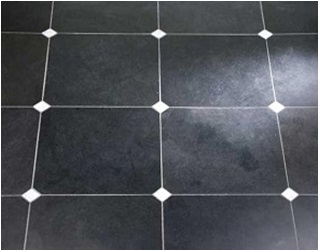

However , these natural stone tiles do not come in the standard thickness. The thickness usually varies between 1 inch , 1.5 inch and 2 inch thick tiles.
Depending upon its application, the black limestone tiles can be used either in the matte or gloss finish. The matte finish tiles do not need much maintenance.
Kota Stone Tiles
The kota stone is a type of dolomite stone available in the variations of light green , gray and blue colors. The kota stone tiles are used for both interior and as well as outdoor applications.
The kota stone tiles offer reasonably good strength and the joint free surface finish to the floor. It is mainly used as floor tiles. It is available in both matte and the glossy finish.
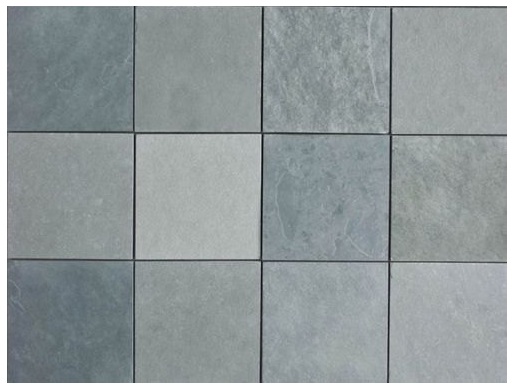
The kota stone tiles are relatively cheaper as compared to the marble and granite tiles. However, it costs more than the black limestone floor tiles.
The kota stone tiles come in variations of light green, gray, blue and yellow color shade. It is difficult to get a uniform color lot in kota tiles. Despite the color variations, the kota stone floor looks very good.
Shahabad Stone Tiles
The Shahabad stone tile is a very good low cost option for the exterior flooring. Especially on the pathways, patio floor and other such landscape spaces.
The Shahabad stone is a type of slate stone with granular surface finish. It varies in color shade of light yellow and gray colors. The Shahabad stone tiles are used mainly for outdoor applications due to its strength and texture.
The Shahabad stone tiles are extensively used for exterior pavements, pathways, parking area and other such outdoor spaces.
The Shahabad stone tiles are generally supplied in standard sizes ( 24 inch by 36 inch ). However, depending upon the floor design, it can be cut into smaller pieces of suitable sizes.

The Shahabad stone floor tiles can be direct fitted on the compacted ground surface. It is fitted on a layer loose sand or any other fine gravel.
The tile joints are sealed with cement slurry paste. The natural finish of the Shahabad stone is matte with rough texture. Suitable transparent floor paint can be applied to give gloss finish.
Ceramic Tiles
The ceramic tiles are mainly used as wall tiles and well known for its stunning looks. These tiles are available in widest range of colors, patterns, and designs. The ceramic tiles are manufactured using some natural mineral ingredients and fired at high tempreature.
The ceramic tiles are used everywhere including kitchen , bathroom, house floor and exterior floor as well. It is the most commonly used tile produced by almost all leading tile companies.
The ceramic tiles are made up of mixture of common natural materials such as white clay, talc, sand, feldspar, dolomite and calcite. This mixture is poured into the tile molds then pressed and fired in the kiln.
The latest range of ceramic tiles includes tiles specifically made for both residential and for commercial applications.


The ceramic tiles make a great choice especially for the bathroom, kitchen and other wet areas as a wall tile.
The ceramic wall tiles are relatively thinner as compared to the ceramic floor tiles. These tiles are also referred as glazed ceramic tiles.
The wide range of ceramic wall tiles is available in the market. These tiles come in both glossy and as well as matte finish.
The ceramic tiles installation process is also relatively simple and does not need any special tools for its installation.

Ceramic Tile Standard Sizes
The ceramic tiles are available in the market in three standard sizes. The standard sizes are 12 inch by 12 inch, 16 inch by 16 inch and 24 inch by 24 inch.
Most ceramic tiles have high gloss finish. However, you will find ceramic glazed tiles with antiskid properties. Further, the glazed coating on the ceramic tiles can be either high-gloss or matte finish.
The wood design ceramic tiles are also available in the plank size of 6 inch by 30 inch size, and 8 inch by 40 inch size.
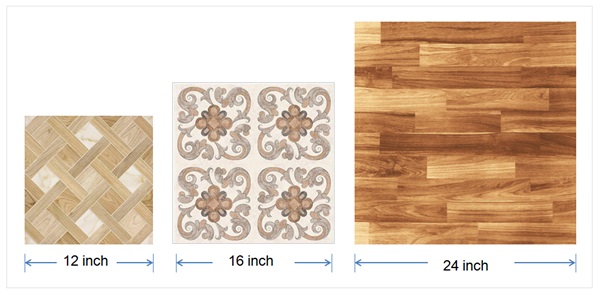
The commercial grade ceramic tiles even come with special coating that makes the tiles scratch resistant and skid resistant. These tiles are also suitable especially for the washrooms and other wet areas.
For ceramic tiles, the upper layer glazed coating and color pigment design layer exists only on the top surface. And therefore, the ceramic tile can get damaged easily if the upper coating is broken exposing the inner body of the tile.
Wood Design Ceramic Tile

Wood Design Ceramic Tile

How To Identify Ceramic And Porcelain Tiles ?
You can easily identify the ceramic tile by reading the product description mentioned on the tile box. Else inspect the back side of the tile and the ceramic tile body will always be in brown or in terracotta clay shade.
The ceramic tile also absorbs water especially on the back surface as compared to the porcelain tile. And therefore, the ceramic tiles are kept in water for few hours prior to its fitting using a cement paste.
Ceramic Tile Rear Side
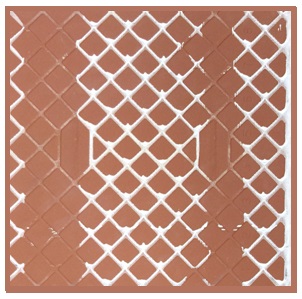
Porcelain Tile Rear Side

Porcelain Tiles
The porcelain tiles are well known for its elegance, silky smooth finish, latest trendy designs and the classy looks.
These tiles can be used as floor and wall tiles. However, due to superior strength, the porcelain tile is a great choice for the floor.
The porcelain tiles are basically the second generation and an improved version of the ceramic tiles. The porcelain tile by composition is derivative of the ceramic tile.
However, the porcelain is made of a more refined and purified raw material minerals as compared to regular ceramic. The porcelain tiles are also fired at much higher temperature for long time.
The use of refined materials and the improved manufacturing process makes the porcelain tiles more dense and less permeable as compared to a regular ceramic tile.
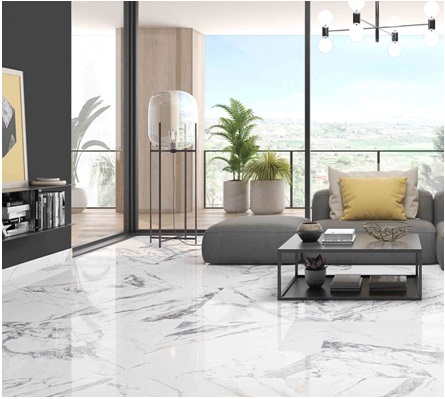
How Porcelain Tile Is Different ?
The porcelain tiles also offer the wide range of choice for colors, designs, patterns, and textures. For most people, it is difficult to gauge the difference between ceramic tile and porcelain tile.
However, the most prominent difference between the ceramic and porcelain tile is the water absorption capacity. The ceramic tiles are more permeable and thus absorb more water ( 3% to 7% by weight ).
Whereas, the porcelain tiles are less permeable and thus absorb far less water ( less than 0.5% by weight ). The high density of the porcelain tile gives additional strength to the tile body.

Standard Porcelain Tile Sizes
The porcelain tiles are available in the market in many standard sizes. Some of the common sizes of porcelain tiles are 12 inch by 12 inch, 16 inch by 16 inch 24 inch by 24 inch, 24 inch by 48 inch and 48 inch by 96 inch.
The porcelain tiles are also available in different finishes. The tile finishes include gloss , high gloss and matte finish.
However, you will find porcelain glazed tiles with good antiskid resistance. Further, the glazed coating on the porcelain tiles can be either high-gloss or matte finish.
The porcelain tiles are also available in wood design. The wood design porcelain tiles plank sizes include of 6 inch by 30 inch size, 8 inch by 40 inch size and 8 inch by 48 inch size.

Porcelain Tiles Vs Ceramic Tile
Vitrified Tiles
The vitrified tile is also an improved and the refined version of the ceramic tile that is even better than the porcelain tile. These tiles can be used on both floor and the walls.
The term vitrify means converting something into the glass and most vitrified tiles have a flawless mirror finish. Further, the vitrified tile joints are almost invisible.
The vitrified tiles are of superior quality and the improved derivative of the porcelain tiles characterized by its flawless glossy finish.
The vitrified tiles are made up of mixture of best quality minerals which include refined clay, silica and quartz. This mixture is compressed in the tile molds at very high temperatures.
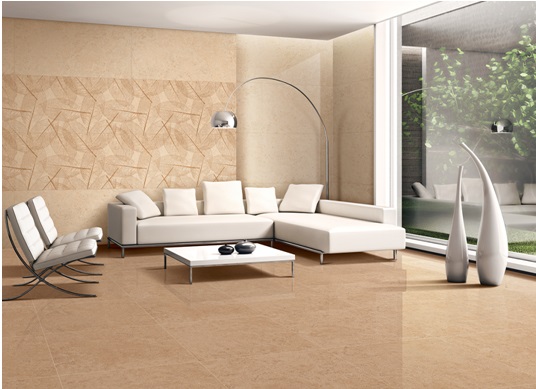
Types Of Vitrified Tiles
Depending upon the special features and the recommended use, different types of vitrified tiles are available in the market under various categories.
The types of vitrified tiles include full body vitrified tile, double charge vitrified tile ( DCVT ), glazed vitrified tile ( GVT ), polished glazed vitrified tile ( PGVT ), Nano polished vitrified tile ( NPVT ), sugar finish vitrified tile ( SFVT ) and the soluble salt vitrified tile ( SSVT ).
Learn More
Vitrified Tile Type | Details | Use |
Full Body Vitrified Tile | Single layer uniform color body shade across the full body of the tile. Most durable vitrified tile. | Most durable vitrified tile. Recommended for heavy traffic area. |
Double Charge Vitrified Tile | Double layer tile body. Upper layer is for color and glazing. Bottom layer is the tile body. Durable vitrified tile. | Durable vitrified tile. Recommended for heavy traffic area. |
Glazed Vitrified Tile ( GVT Tiles ) | Triple layer tile body. Upper layer is glazed coat. Second layer is color and design. Bottom layer is the tile body. | Durable vitrified tile. Recommended for moderate traffic area. |
Polished Glazed Vitrified Tile ( PGVT Tiles ) | Triple layer tile body. Upper layer is polished glazed coat. Second layer is color and design. Bottom layer is the tile body. | Durable vitrified tile. Recommended for moderate traffic area. |
Solluble Salt Vitrified Tile | These tiles are produced using screen printing technology. Not very common. | Delicate vitrified tile. Recommended for low traffic area. |
Nano Polish Vitrified Tile | Based on chemical nano technology. Special nano polish coat for stain resistance. | High Stain Resistance and low maintenance. Recommended for living and bedroom. |
Suger Finish Vitrified Tile | Sugar grains granular surface finish. Special nano coat for stain resistance. | High scratch and skid resistance. Low maintenance. Recommended for living and bedroom. |
How Vitrified Tile Is Different ?
Most people are familiar with the first generation ceramic tiles introduced in the market few decades back.
The ceramic technology has evolved at rapid pace and the second generation porcelain tiles were introduced in the market. The porcelain tiles offer major advantages over ceramic tiles in terms of strength, finish and durability.
However, with the advancement in the ceramic engineering and the tile manufacturing technology, the vitrified tiles were introduced in the market with more advance features.
The vitrified tile is said to be the third generation of ceramic tile manufactured by using highly refined raw material and fired at much higher temperatures.
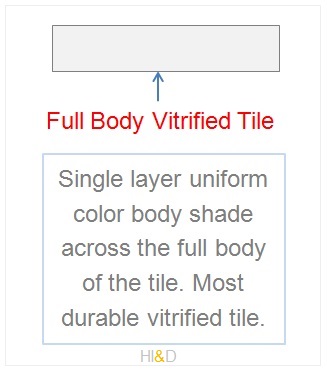


How To identify Vitrified Vs Ceramic Tile ?
The easiest way to identify the vitrified tile is by observing the clarity in the light reflection when placed under the light.
The vitrified tiles produce a mirror quality reflection of the ceiling lights as compared to slightly hazy reflection produced by the porcelain tiles.
The verified tiles are tougher, stronger and more elegant as compared to its predecessors with very less water absorption capacity.
And therefore, vitrified tiles can be used for both interior and exterior spaces. These tiles can handle heavy traffic places like airport and shopping malls.

The vitrified tiles are available in wide range of designs, colors, finishes and textures. The vitrified tiles are expensive as compared to the ceramic and porcelain tiles.
Ultra Slim Unbreakable Vitrified Tiles
The latest range of vitrified tiles are ultra slim tiles. These tiles are just 6 mm thick and are almost unbreakable.
These are multipurpose tiles and can be used either as floor tiles or as a wall tile. These tiles are best suited for tile-on-tile option.
The slim range of ultra thin tiles are just 6 mm thick. Due to only 6mm thickness, these tiles can be easily fixed on the existing tile floor using a special tile-on-tile fixing material.
Standard Vitrified Tile Sizes
The Vitrified tiles are available in the market in many standard sizes. Some of the common sizes of porcelain tiles are 24 inch by 24 inch, 24 inch by 48 inch, 30 inch by 60 inch, and special large size 48 inch by 96 inch.
The Vitrified tiles are also available in different finishes. The tile finishes include gloss finish, high gloss finish and the matte finish.
Wood Look Tiles
The wood look tiles are also referred to as wood design tiles are the latest buzz word in the floor tile market. The natural wooden flooring and laminated wooden flooring are already a very popular option for the flooring.
However, the natural wooden and laminated flooring has some major limitations and cannot match the performance and strength of the tile floor. Further, the use of natural wooden flooring is restricted to only dry areas of the house.
The wood design tiles are available in both ceramic, vitrified as well as porcelain body. The wood design tiles are available in all standard tile shapes and sizes.
Wood Look Ceramic Tiles


Wood Look Porcelain Tiles
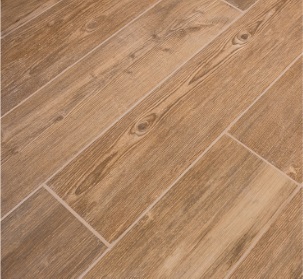

However, the wood design tiles in the plank shape and sizes have a closest resemblance with the actual wood floor. The wood design tiles can be used for any wet area including kitchen and bathroom.
The wood design tiles can be used for both wall and floor tile work. The installation process is same as that of any other floor and wall tiles installation.
Cement Tiles
The cement tiles is another most commonly used category of tiles suitable for both interior and exterior applications. The cement tiles are mainly used for floor tiles.
The cement ties are available in different patterns, designs and finishes. The plane cement tiles are used for interior tiles.
Whereas, the glazed and the embossed cement tiles are used for pavements and also for the parking lots due to its antiskid properties.
Interior Cement Tiles

Exterior Cement Tiles

The cement tiles are made up of mixture of sand ( or other fine gravel ) cement and water. Some admixtures and color pigments are added in the upper layer cement slurry used to finish the tile surface.
The glazed paint coat can be applied on the tile surface to enhance the tile color and finish . The cement tiles are available in both matte and gloss finish.
The cement tiles are also available in duel color decorative designs and patterns.
The mosaic tiles is another type of cement tile. This is a two layer tile with cement mortar base layer and the top terrazzo layer. This tile needs polishing after being fixed.
Cement Tile Designs

Decorative Cement Tile

Paver Tiles
Pavement Tiles
Paver Blocks
Interlocking Blocks
The paver tiles are also alternately called as paver blocks, paver interlocking blocks or pavement blocks. The paver blocks offer an excellent low cost, easy to install and the sturdy flooring option for the outdoor areas.
The paver block tiles are available in wide range of colors, designs, shapes and textures. The paver blocks are available in glossy and matte finish.
Paver Blocks

Pavement Tiles
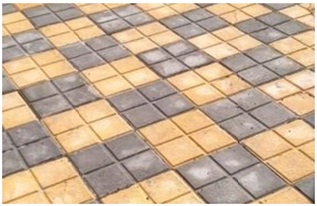
The paver blocks are extensively used for public places, pathways, roadside footpaths, parking areas, house courtyards and other such spaces.
The paver blocks can be very easily laid on the well compacted ground. The paver blocks can be either be grouted with the cement slurry or simply placed on the layer of the fine gravel or sand.
Paver Block Pathway

Pavement Tiles Pathway

The paver block floor can easily withstand moderate heavy vehicle movement due to its thickness and the interlocking ability.
The paver tiles are a low maintenance floor and do not get easily damaged. The broken blocks can be easily replaced with new one without any problem.
The paver blocks are made up of cement, sand and gravel with the help of block making machine.
Terracotta Tiles
The terracotta tiles are the oldest ceramic tiles made up of clay. The term terracotta is originated from an Italian word which means backed earth.
The terracotta tiles existed for a long time and we can see its application in many heritage buildings across the world.
The terracotta tiles are characterized by a typical red color derived from the high iron content present in the clay used to manufacture these tiles.
Terracotta Tiles

Terracotta Tiles

The terracotta tiles are not backed at high temperature and therefore, remain relatively weak which limits its application.
Another major disadvantage of the terracotta tiles is the tendency to absorb and retain high water content. This property can be controlled by applying glazed coating on the tile surfaces.
Different types of terracotta tile designs are easily available in both ceramic and the porcelain tiles. The terracotta tiles can be used for both interior and exterior use. It is widely used on the floor and also for wall cladding.
Elevation Tiles
Elevation tiles are specially designed for the treatment of building elevations. These tiles are available with ceramic, porcelain, and vitrified tile body. Also known as decorative wall tiles or feature wall tiles, are specifically designed to enhance the aesthetic appeal of vertical surfaces such as walls.
Elevation tiles are available in wide range of designs, patterns, sizes, and colors. These tiles often have unique patterns, textures, or finishes that make them visually appealing. However, elevation tiles with various stone masonry designs are the most popular tiles.

It is important to note that elevation wall tiles often offer more design flexibility, and the size choices can vary widely depending on the specific style or design concept. Some tile companies also offer custom sizes and shapes are to cater to specific architectural and design requirements.
While there is no specific standard size for elevation wall tiles, however, 24 by 12 inches is the most widely used size.
Large Format Tiles
Large format tiles have gained significant popularity in recent years. They have become a favored choice among homeowners, interior designers, and architects for various reasons. The demand for large format tiles continues to grow due to their modern aesthetic, sleek design, and ability to create a visually appealing and seamless look.
Large format tiles, also known as large format porcelain tiles or simply LFTs, refer to tiles that are significantly larger in size compared to traditional ceramic or stone tiles.

Large format tiles can also make bold visual statements. Their substantial size draws attention and becomes a focal point within the space. They can be used creatively to add drama, visual interest, and a sense of grandeur to areas like feature walls, fireplaces, or entryways.
When selecting large format tiles, it’s important to consider the overall design concept, the scale of the space, and the desired visual impact. With their striking presence and versatility, large format tiles offer numerous opportunities for creating visually stunning interiors.
PVC Vinyl Tiles
PVC floor tiles, also known as vinyl floor tiles, are a type of resilient flooring that is commonly used in residential and commercial spaces. They are made from polyvinyl chloride (PVC), a synthetic material that is known for its durability, water resistance, and easy maintenance.
PVC floor tiles are highly durable and can withstand heavy foot traffic, making them suitable for areas with high usage, such as homes, offices, retail stores, and healthcare facilities.
PVC tiles are waterproof, which means they can be installed in areas prone to moisture, such as kitchens, bathrooms, and basements, without worrying about water damage. However, excessive exposure to wet conditions can cause the problem of peeling off and PVC tiles can get detached from the floor.
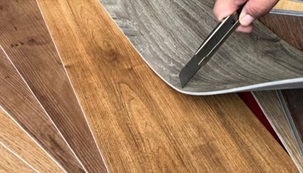
It’s important to note that while PVC floor tiles have numerous advantages, they also have some potential drawbacks. For instance, some types of PVC tiles may emit volatile organic compounds (VOCs), so it’s important to choose low VOC or phthalate-free options if you are concerned about indoor air quality.
Further, PVC tiles can be sensitive to direct sunlight with low UV resistance. Exposure to direct sunlight may fade or discolor tiles over time if exposed to excessive UV radiation.
When considering PVC floor tiles, it’s a good idea to research different brands, read customer reviews, and consult with professionals to ensure you select a high-quality product that suits your specific needs.
Vinyl Tiles Installation

Wooden Tiles
Wooden tiles are a popular and adaptable flooring and wall covering option. It combines the timelessness of wood’s aesthetic appeal with the durability, technical advantages, and convenience of tiles.
These tiles can be found in a wide range of contexts, from domestic houses to high-traffic areas of commercial buildings. Wooden floors have a warm and natural appearance while also delivering the benefits of a rich appearance, durability, and ease of care.

Wooden tiles are mainly divided into two sorts. The first variety consists of engineered wooden tiles, whereas the second consists of natural, solid hardwood tiles. Both tiles provide typical wooden floor aesthetics, but their technical properties and cost differ.
In this complete guide, we will look at many types of wooden tiles, their benefits and drawbacks, the installation procedure, and their uses in flooring and wall coverings.







